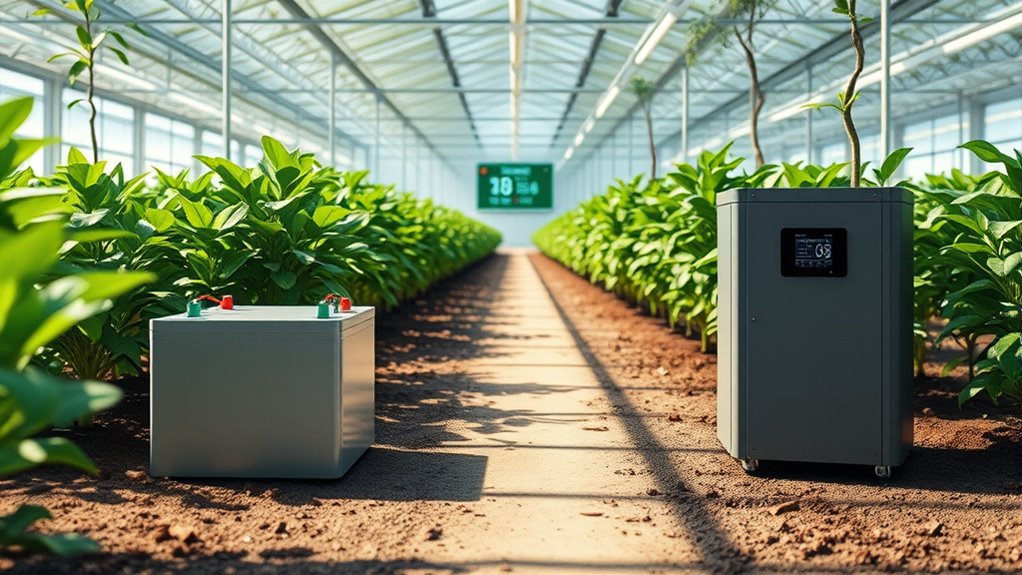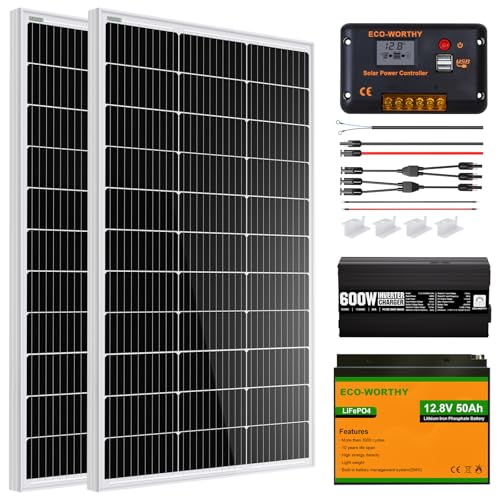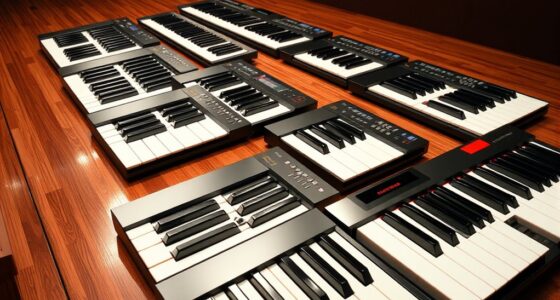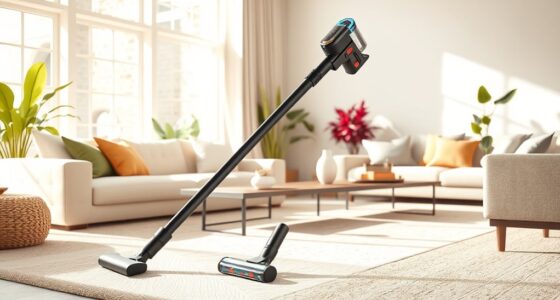If you want to power your greenhouse sustainably, I've found that the 1500 Watt Pure Sine Wave Inverter and the Renogy 12V 200Ah Deep Cycle AGM Battery are excellent choices. The ECO-WORTHY Solar Panel Kits also provide efficient energy solutions. Don't overlook the specialized inverters, like those for Greenworks 40V batteries, which are super handy. Each option offers unique features to suit different needs. Stick around to discover more about choosing the best systems for your plants!
Key Takeaways
- Deep Cycle Batteries: Opt for AGM or lithium deep cycle batteries with a 200Ah rating for reliable power to greenhouse systems and low self-discharge rates.
- Pure Sine Wave Inverters: Use pure sine wave inverters, like the 1500W model, to ensure safe operation of sensitive greenhouse equipment and reduce noise during heavy use.
- Solar Power Integration: Consider solar panel kits, such as the ECO-WORTHY 200 Watt Starter Kit, for sustainable energy generation and efficient charging of batteries.
- Safety Features: Look for inverters with overvoltage protection and intelligent cooling systems to protect equipment and enhance operational longevity.
- Installation and Maintenance: Choose user-friendly systems with clear installation instructions and regular maintenance checks to ensure efficient performance in greenhouse settings.
1500 Watt Pure Sine Wave Power Inverter DC 12V to AC 110V/120V
When it comes to powering essential greenhouse equipment, the 1500 Watt Pure Sine Wave Power Inverter is an excellent choice for those looking for reliability and versatility. I've found its 1500W continuous output is perfect for running everything from lights to fans. The two AC outlets and USB charging options are super convenient, making it easy to connect multiple devices. Plus, the intelligent cooling system keeps it from overheating, which is a huge relief. Though it can get a bit noisy under heavy use, the overall performance has been fantastic for my off-grid setup, ensuring my plants thrive year-round.
Best For: Those seeking a reliable power solution for off-grid living, road trips, and camping activities.
Pros:
- Versatile with multiple charging options, including 2 AC outlets and USB ports for various devices.
- High efficiency with up to 94% conversion, ensuring effective power use.
- Durable design made from high-quality aluminum alloy, resistant to bending and heat.
Cons:
- Cooling fan can be noisy under heavy loads, which may be distracting.
- Potential remote control malfunctions, leading to user inconvenience.
- Reports of overheating or failure when operating at peak capacity for extended periods.
Renogy Deep Cycle AGM Battery 12 Volt 200Ah
The Renogy Deep Cycle AGM Battery 12 Volt 200Ah is an excellent choice for anyone looking to power their off-grid greenhouse effectively. With a self-discharge rate of just 3%, it guarantees reliable energy storage without constant maintenance. This battery can handle heavy-duty applications, delivering up to 2000A of discharge current, making it perfect for running refrigerators or low-power heaters. Plus, its wide temperature range means it performs well even in colder climates. Just keep in mind its weight of over 100 lbs for installation. Overall, it's a solid investment for sustainable greenhouse energy needs.
Best For: Individuals seeking a reliable and maintenance-free power source for off-grid applications like greenhouses, RVs, or marine use.
Pros:
- Excellent discharge performance with high current capability, ideal for heavy-duty applications.
- Low self-discharge rate ensures long shelf life and reliable energy storage.
- Wide operational temperature range allows consistent performance in various climates.
Cons:
- Weighs over 100 lbs, making installation and handling challenging.
- Mixed reviews regarding warranty claims, particularly with third-party inverters.
- Heavy packaging may lead to shipping damage, despite the battery typically being intact.
ECO-WORTHY 200 Watt 12V Complete Solar Panel Starter Kit
If you're looking for a reliable power solution for your greenhouse or small agricultural setup, the ECO-WORTHY 200 Watt 12V Complete Solar Panel Starter Kit is an excellent choice. This kit includes everything you need—200W solar panels, a 30A charge controller, a 50Ah lithium battery, and a 600W inverter. Its monocrystalline panels boast high efficiency and durability, while the lithium battery outlasts traditional options. Users have successfully powered lights and small appliances, with the potential for expansion. Just be prepared for some installation learning curves, and you'll enjoy sustainable power for your plants in no time!
Best For: The ECO-WORTHY 200 Watt 12V Complete Solar Panel Starter Kit is best for RV owners, campers, and small agricultural setups looking for a reliable and sustainable power solution.
Pros:
- High efficiency with 21% conversion rate from monocrystalline solar panels.
- Long-lasting lithium battery with 4000 to 15000 recharge cycles.
- Beginner-friendly installation with potential for system expansion.
Cons:
- Mixed user experiences with installation and component functionality.
- Some challenges reported with customer service and support.
- May require basic knowledge for optimal setup and performance.
ECO-WORTHY 4.8KWH Solar Power Complete Kit
For anyone looking to harness solar power efficiently, the ECO-WORTHY 4.8KWH Solar Power Complete Kit stands out with its impressive 3000W inverter that converts 24VDC to 110VAC, making it ideal for powering various appliances in greenhouses and other off-grid settings. This kit includes six bifacial solar panels and a robust lithium battery, generating about 5KWh/day under peak sunlight. While installation may require some technical skill, many users appreciate the energy savings and performance. However, be prepared for mixed customer service experiences, and consider potential upgrades for maximum efficiency. Overall, it's a solid choice for sustainable power solutions.
Best For: Those seeking a reliable and efficient solar power solution for off-grid living, including homes, cabins, and RVs.
Pros:
- High energy output of approximately 5KWh/day under optimal sunlight conditions.
- Bifacial solar panels provide 33% more energy than traditional panels, enhancing efficiency.
- Robust lithium battery with over 3000 deep cycles ensures long-lasting performance.
Cons:
- Installation can be complex and may require additional cables and connectors.
- Mixed customer service experiences, with some users reporting poor communication and warranty issues.
- The system does not sell excess solar back to the grid, which may be misleading for some buyers.
1000 Watt Power Inverter for Vehicle RV Truck
Looking for a reliable power source for your RV or truck? The ALEOPIX 1000 Watt Power Inverter has you covered. With 1000W continuous and 2000W peak power, it efficiently converts 12V DC to 110/120V AC. Weighing just 1.87 pounds, it's portable and easy to set up. You'll appreciate the two AC outlets and fast USB charging options. Plus, its safety features guarantee a worry-free experience. Users rave about its performance for everything from road trips to emergency power needs. If you're seeking dependable power on the go, this inverter's sturdy design and intelligent cooling system make it a smart choice.
Best For: Those seeking a reliable and portable power solution for RVs, trucks, and outdoor activities.
Pros:
- Multiple output options including AC outlets and USB ports for versatile charging.
- Lightweight and compact design for easy transport and setup.
- Comprehensive safety features ensure protection against various electrical issues.
Cons:
- Maximum load for the cigarette lighter is limited to 200W, which may not suffice for some devices.
- Performance may be affected under extremely high temperatures despite the cooling system.
- Limited peak power compared to some higher-capacity inverters, potentially restricting usage for larger appliances.
SUNGOLDPOWER 10000W 48V Solar Hybrid Inverter
The SUNGOLDPOWER 10000W 48V Solar Hybrid Inverter stands out as an excellent choice for greenhouse operators seeking a reliable power solution. With a rated output of 10,000W and a max peak power of 20,000W, it easily supports various loads. I appreciate its compatibility with multiple battery types and the ability to operate without batteries. The built-in WiFi module makes monitoring a breeze. Users report efficient performance and significant savings on electric bills, although some experienced minor issues with battery charging. Overall, it's a smart investment for sustainable greenhouse energy management.
Best For: Greenhouse operators seeking a reliable and efficient solar power solution for energy management.
Pros:
- High power output: Rated at 10,000W with a peak of 20,000W, suitable for various loads.
- Versatile battery compatibility: Supports multiple battery types and allows for battery-free operation.
- User-friendly monitoring: Built-in WiFi module enables easy mobile app monitoring of performance.
Cons:
- Mixed customer support: Some users report delays and unresolved issues with customer assistance.
- Minor technical issues: Users have encountered problems with battery charging and fault codes.
- Reliability concerns: A few customers expressed worries regarding the long-term reliability of the product.
Power Inverter for Greenworks 40V Battery (350W, 2-Port)
If you're someone who values reliability and portability in outdoor power solutions, the Power Inverter for Greenworks 40V Battery is an excellent choice. Weighing just 2.4 pounds, this 350W inverter converts DC 40V to AC 120V, making it perfect for smaller devices like laptops and coolers. With six output ports, including USB options, it's versatile for various needs. I love the built-in LED light for emergencies and the pure sine wave technology that guarantees clean power. Just remember, it's not meant for high-power devices. Overall, it's a solid backup option for outdoor activities and home use.
Best For: Outdoor enthusiasts and campers looking for a portable power solution to charge small devices and provide emergency lighting.
Pros:
- Versatile output options with six ports, including USB-A and USB-C, accommodating various devices.
- Lightweight and portable design at just 2.4 pounds, making it easy to carry for outdoor activities.
- Pure sine wave technology ensures clean power, minimizing noise and interference for sensitive electronics.
Cons:
- Limited power capacity of 350W, unsuitable for high-power devices like sump pumps.
- Compatibility issues as it only works with Greenworks 40V batteries and not with other brands like Ryobi.
- Plastic construction raises durability concerns and some users report difficulties with AC socket compatibility.
200W Power Inverter for Dewalt 20V Max Battery
For anyone needing reliable portable power, the W Power Inverter for Dewalt 20V Max Battery is a game changer. This 200W inverter converts 20V DC to 110V-120V AC, giving me the flexibility to charge my devices anytime. It includes a 5Ah battery, a charging station, and multiple ports for USB and AC connections. I love its compact size, making it perfect for outdoor activities like camping. Plus, built-in safety features protect my devices from overload and overheating. While it may not power heavy-duty tools, it excels with smaller appliances, providing significant run time for my essential gadgets.
Best For: Those seeking reliable portable power solutions for charging smaller devices during outdoor activities or emergencies.
Pros:
- Compact and lightweight design makes it easy to transport for camping and fishing trips.
- Multiple charging options with USB-A and Type-C ports, as well as an AC outlet, cater to various devices.
- Built-in safety features protect devices from overload, low voltage, and overheating, ensuring safe usage.
Cons:
- Limited power capacity may not support heavy-duty tools or larger appliances effectively.
- Mixed reviews on LED light quality, with some users finding it less bright than expected.
- Voltage output issues reported by some users, indicating performance may vary in certain situations.
ECO-WORTHY Inverter Charger 55A with 1000W Pure Sine Wave Inverter
Looking for a reliable power solution for your greenhouse? The ECO-WORTHY Inverter Charger 55A with its 1000W pure sine wave inverter is an excellent choice. It efficiently powers essential appliances like microwaves and refrigerators, thanks to its ability to handle deep-cycle 12V LiFePO4 batteries. I love its automatic switch to battery power within 20ms during grid failures, ensuring uninterrupted operation. With intelligent charging technology, it maintains battery health while offering multiple safety features. Although some users suggest adding a fuse holder for improved safety, this unit considerably upgrades older systems, making it perfect for sustainable greenhouse power needs.
Best For: The ECO-WORTHY Inverter Charger 55A is best for greenhouse owners seeking a reliable power solution for essential appliances powered by deep-cycle 12V LiFePO4 batteries.
Pros:
- Efficiently powers appliances like microwaves and refrigerators.
- Automatic switch to battery power within 20ms during grid failures for uninterrupted operation.
- Intelligent charging technology maintains optimal battery health with multiple safety features.
Cons:
- Some users recommend adding a fuse holder for enhanced safety.
- Reported issues with AC output wiring may require attention.
- Cooling fan activation at higher temperatures may cause noise.
Power Inverter for Greenworks 40V Battery (350W, 2-Port DC to AC)
The Power Inverter for Greenworks 40V Battery is an excellent choice for anyone needing reliable portable power for smaller devices in outdoor settings. Weighing just 2.4 pounds, it's easy to transport and converts DC 40V to AC 120V at a maximum output of 350W. With six output ports, including USB and AC options, I can power everything from mini coolers to laptops. Plus, the built-in LED emergency light offers extra utility during camping trips. While it's not meant for high-power devices, it's perfect for my greenhouse needs, providing clean power with its pure sine wave technology.
Best For: Those looking for a portable power solution for small devices during outdoor activities or as a backup power source.
Pros:
- Versatile: Equipped with multiple ports including USB and AC, making it suitable for various small electronics.
- Lightweight and Portable: At only 2.4 pounds, it's easy to carry for camping or emergency use.
- Clean Power Output: Utilizes pure sine wave technology, ensuring safe and efficient power delivery.
Cons:
- Limited Power Capacity: Not suitable for high-power devices such as sump pumps or large appliances.
- Compatibility Issues: Only works with Greenworks 40V batteries, excluding other brands like Ryobi.
- Durability Concerns: Some users report worries about the plastic construction and AC socket compatibility.
2000 Watt Solar Power Inverter with 3 AC Outlets and 2 USB Charging Ports
When you need reliable power for your greenhouse, the 2000 Watt Solar Power Inverter stands out with its three AC outlets and two USB charging ports. This inverter efficiently converts 12V DC to 110V-120V AC, making it perfect for off-grid solar systems or even RVs and trucks. With a continuous power output of 850-950W and peak power of 1600-2000W, it handles a variety of devices. Plus, it boasts advanced safety features like over-voltage and over-temperature protection. Its durable design and cooling fan guarantee a long lifespan, making it a smart investment for sustainable gardening.
Best For: Those seeking a reliable and portable power solution for off-grid solar systems, RVs, and outdoor activities.
Pros:
- Versatile power options with three AC outlets and two USB charging ports for multiple devices.
- Advanced safety features provide protection against over-voltage, over-load, and short circuits, ensuring safe operation.
- Durable aluminum housing and high-performance cooling fan enhance longevity and performance in various environments.
Cons:
- Modified sine wave output may not be suitable for sensitive electronics and appliances.
- Continuous power output of 850-950W might limit usage for high-demand devices.
- Customer ratings indicate mixed reviews, with an average of 3.8 out of 5 stars.
Power Inverter for Greenworks 40V Battery
For anyone seeking a reliable power solution in their greenhouse or during outdoor activities, the Power Inverter for Greenworks 40V Battery stands out with its pure sine wave technology. This 350W inverter boasts six output ports—three USB-A, one USB-C, and one AC outlet—making it perfect for powering devices like laptops and mini coolers. It's equipped with a bright LED light for emergencies and features a built-in smart chip for safety. Weighing just 3.4 pounds, its ergonomic handle makes it easy to carry. While user feedback mentions a lack of instructions, I've found it easy to use and versatile for various needs.
Best For: Individuals looking for a versatile and portable power solution for outdoor activities, emergencies, or RV camping.
Pros:
- Pure Sine Wave Technology: Ensures safe operation for sensitive electronics and reduces electrical noise.
- Multiple Output Options: Features six different ports, including USB-A, USB-C, and an AC outlet, allowing for simultaneous device charging and use.
- Emergency Light & Portability: Includes a bright LED emergency light with multiple modes and an ergonomic handle for easy transport.
Cons:
- Limited Customer Ratings: Currently has a low average rating of 3.1 out of 5 stars from users.
- Lack of Instructions: User feedback indicates insufficient instructions for setup and usage.
- Weight Consideration: While portable, it may be heavier than other compact power solutions, weighing 3.4 pounds.
DEWALT DXAEPI1000 Power Inverter 1000W Car Converter
Looking for a reliable power source while working in greenhouses? The DEWALT DXAEPI1000 Power Inverter is a solid choice. With 1000 watts of continuous power, I can easily plug in multiple devices through its dual 120V AC outlets and USB ports. Its LCD display keeps me informed on power consumption and battery status. Weighing just 4.25 pounds, it's portable enough for any job. I appreciate that it shuts off before draining the battery completely, ensuring I don't get stranded. While some users report reliability issues, I find it provides good value for basic electrical needs in the greenhouse.
Best For: The DEWALT DXAEPI1000 Power Inverter is best for contractors and individuals needing a portable power source for basic electrical needs away from 120V power sources.
Pros:
- Powerful Performance: Provides 1000 watts of continuous power, suitable for multiple devices.
- User-Friendly LCD Display: Offers real-time information on power consumption and battery status.
- Portable Design: Lightweight at 4.25 pounds, making it easy to transport for various jobs.
Cons:
- Mixed Reliability: Some users report issues with build quality and reliability.
- Frequent Beeping: Reports of annoying beeping when not connected to a running vehicle can be disruptive.
- Performance Limitations: May struggle with higher power demands, especially with long heavy cords.
LiTime 3500W Pure Sine Wave Solar Inverter Charger
The LiTime 3500W Pure Sine Wave Solar Inverter Charger stands out as an excellent choice for greenhouse operators seeking a reliable energy solution. This all-in-one unit converts 48V DC to 120V AC, integrating an 80A MPPT charge controller that enhances efficiency. With multiple output modes and smart charging options, it adapts seamlessly to various battery configurations. The integrated LCD screen provides real-time monitoring, ensuring I'm always informed about my system's performance. While some users have raised concerns about installation and customer service, the inverter's stability and capability make it a solid investment for sustainable greenhouse energy management.
Best For: Greenhouse operators seeking a reliable and efficient solar energy solution for managing their energy needs.
Pros:
- Integrates an 80A MPPT charge controller for enhanced energy efficiency.
- Offers multiple output modes and smart charging options for flexibility with battery configurations.
- Features an integrated LCD screen for real-time monitoring of system performance.
Cons:
- Mixed reviews regarding usability and installation processes.
- Some users have reported issues with customer service and technical specifications.
- Lacks UL certification and has been criticized for incomplete manuals.
Factors to Consider When Choosing Batteries and Inverters for Greenhouses

When I think about choosing batteries and inverters for my greenhouse, I focus on a few key factors. It's essential to assess power requirements, select the right battery type, and guarantee inverter compatibility. Plus, I can't overlook efficiency, performance, and safety features that keep everything running smoothly.
Power Requirements Assessment
To guarantee a successful greenhouse operation, I prioritize a thorough assessment of power requirements before selecting batteries and inverters. First, I calculate the total wattage of all devices to confirm the inverter can handle the continuous load. I also consider peak power demands, especially for motors and compressors that may need a surge capacity. Next, I evaluate the battery capacity for low sunlight periods, using the formula: Battery Capacity (Ah) = Total Wattage (W) x Hours of Use (h) / Battery Voltage (V). Additionally, I look at the depth of discharge (DoD) for the battery type, aiming for 50-80% for lead-acid and up to 90% for lithium. Finally, I incorporate a buffer for inefficiencies in power conversion.
Battery Type Selection
Choosing the right battery type for your greenhouse can greatly impact energy efficiency and system performance. I prefer deep cycle batteries, like AGM or lithium, because they can discharge deeply and provide consistent power without damage. It is crucial to check the self-discharge rate—look for AGM batteries with around 3% to maintain charge during downtime. Make sure the amp-hour rating meets your energy demands, especially during peak usage; a 200Ah battery is often a solid choice. Also, consider temperature tolerance; batteries should perform well in various greenhouse conditions, ideally below 32°F (0°C). Finally, a higher cycle life, such as over 3000 cycles for lithium batteries, means longer-lasting performance and reduced replacement costs, which is a big win.
Inverter Compatibility Factors
Having selected the right battery type for your greenhouse, the next step involves verifying your inverter complements that choice effectively. First, check the voltage and power output requirements; inverters typically come in 12V, 24V, or 48V configurations. It's essential that the inverter's continuous power output exceeds the total wattage of your devices. For instance, a 1500W inverter works well for devices totaling 1500W. I also recommend looking for inverters with an efficiency rating above 90% to minimize energy loss. Compatibility with your battery type—be it AGM, lithium, or flooded—is important, as some inverters are designed specifically for certain chemistries. Finally, verify the inverter has built-in protection features to safeguard your setup.
Efficiency and Performance
While considering the efficiency and performance of batteries and inverters for your greenhouse, it's vital to prioritize high conversion efficiency and longevity. I've found that inverters with conversion efficiencies up to 94% minimize energy losses, which is significant for keeping operational costs down. When selecting batteries, look for low self-discharge rates; for instance, AGM batteries with around 3% are excellent for long-term storage. Confirm the inverter's peak power output matches your greenhouse's total appliance wattage, typically ranging from 1000W to 10,000W. Also, consider battery cycle life—lithium batteries provide over 3,000 deep cycles compared to lead-acid batteries' 300 to 400 cycles. Finally, verify your inverter can handle surge power, like 3000W, to tackle high-demand appliances effectively.
Safety Features Importance
When I evaluate batteries and inverters for greenhouses, I always emphasize the importance of safety features. Overvoltage and short circuit protection are essential to prevent equipment damage and guarantee safe operation. I look for inverter models with intelligent cooling systems, which help prevent overheating during heavy use. Additionally, a pure sine wave output is critical for protecting sensitive electronic devices in my greenhouse, as it reduces the risk of equipment failure. Battery management systems (BMS) are another key feature, monitoring voltage, current, and temperature to prevent issues like overcharging and overheating. I also make it a point to perform regular maintenance checks on these safety features, which can greatly extend the lifespan of my batteries and inverters.
Installation and Setup Ease
How easy is it to install and set up batteries and inverters for my greenhouse? It really depends on the system you choose. I make sure to take into account the installation requirements, as some setups might need specific tools or configurations. A user-friendly inverter design with clear instructions is a must for me, especially since my technical skills are limited. I also pay attention to the weight and dimensions; heavier units often require extra support during installation. Compatibility with my existing electrical systems is vital, too, as I want everything to integrate smoothly. Finally, I look for products that come with all the necessary components, which simplifies the setup process and minimizes additional purchases.
Maintenance and Lifespan
After getting my batteries and inverters set up, I quickly realized that maintenance and lifespan are just as important as installation. I learned that the self-discharge rate of batteries plays an essential role; I prefer those with a low rate of around 3% to minimize charge loss during storage. Deep cycle batteries can last anywhere from 300 to over 3000 cycles, depending on how I manage their discharge and charging. Regular maintenance, like checking fluid levels and cleaning terminals, has helped extend their lifespan. For inverters, I prioritize models with high conversion efficiency—up to 94%—to reduce energy loss. Finally, keeping everything within the specified temperature range is critical for maximizing performance and longevity.
Budget Considerations
Budgeting for batteries and inverters in my greenhouse requires careful consideration of several key factors to guarantee I make the best investment. First, I assess the total power requirements of my equipment, ensuring the inverter can handle both continuous and peak power demands. Next, I evaluate battery options, weighing the upfront costs of lead-acid versus lithium; while lithium has a higher initial price, its longer lifespan and lower maintenance can justify the investment. I also consider the efficiency ratings of inverters, as better efficiency minimizes energy losses and operating costs. Additionally, I account for installation expenses, including wiring and labor. Finally, I plan for future upgrades, opting for scalable systems that accommodate increased energy needs without requiring full replacements.
Frequently Asked Questions
How Do I Maintain Batteries for Optimal Performance?
To maintain batteries for peak performance, I regularly check the charge levels and clean the terminals. I also make sure they're stored in a cool, dry place to prevent overheating. I recharge them before they drop too low, and I avoid letting them sit unused for extended periods. Monthly inspections help me catch any issues early. By keeping a consistent maintenance routine, I've noticed a significant improvement in their lifespan and efficiency.
Can I Use Used Batteries in My Greenhouse Setup?
Picture a garden thriving under the sun, powered by old batteries. I've found that using used batteries in my greenhouse can be a double-edged sword. While they might save some cash, their efficiency and lifespan often drop. I've learned to be cautious and check their condition first. If they're still reliable, I'd consider using them, but it's crucial to monitor their performance closely to avoid surprises in my energy needs.
What Are the Signs of a Failing Inverter?
When I notice signs of a failing inverter, I pay close attention to unusual noises or overheating. If the display shows inconsistent readings or error codes, that's definitely a red flag. I've also seen performance issues, like my devices not receiving the correct voltage. If the inverter struggles to start up or shuts down unexpectedly, I know it's time to investigate further. Staying alert can save me from bigger problems down the road!
How Long Do Greenhouse Batteries Typically Last?
Did you know that the average lifespan of a deep-cycle battery is around 3 to 5 years? When it comes to greenhouse batteries, their longevity can depend on usage and maintenance. I've found that regularly checking their charge and keeping them clean can greatly extend their life. If you're diligent, you might even get a bit more than the average lifespan. Just remember, proper care makes all the difference!
Are There Specific Brands to Avoid for Greenhouse Use?
I've found that some brands just don't hold up well in greenhouse environments. For instance, avoid off-brand batteries that might skimp on quality, as they often fail sooner than expected. I've also heard mixed reviews about certain budget inverters; they can be unreliable when you need them most. It's essential to stick with well-reviewed brands that specialize in energy solutions for horticulture to guarantee your plants thrive without interruptions.
Conclusion
In summary, choosing the right batteries and inverters for your greenhouse can be as essential as the sunlight that nurtures your plants. With options like pure sine wave inverters and deep cycle batteries, you can power your setup sustainably and efficiently. Keep in mind the size and energy demands of your greenhouse as you make your selections. By investing wisely, you'll create an environment where your plants can thrive, just like a well-tended garden blooms in spring.
























